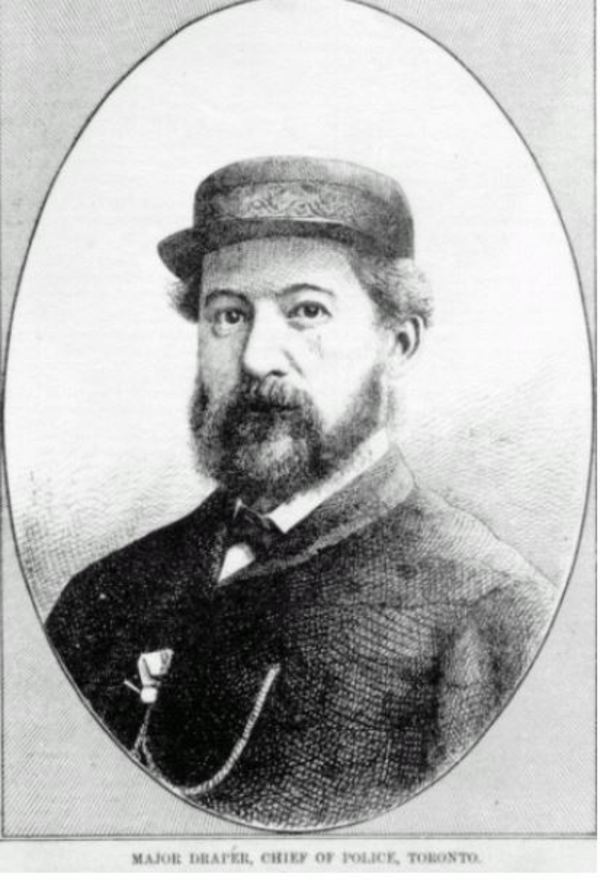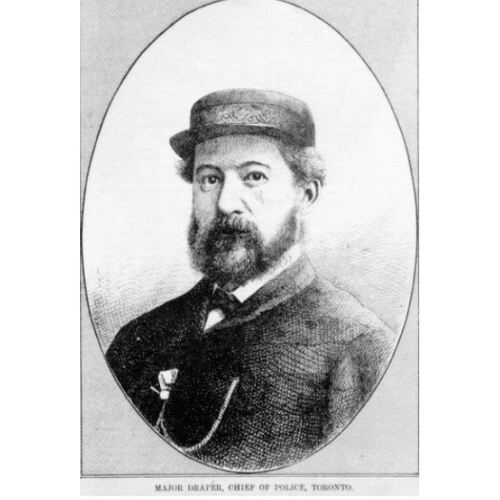
Source: Link
DRAPER, FRANCIS COLLIER, lawyer, militia officer, and office holder; b. 3 March 1837 in Toronto, son of William Henry Draper* and Augusta White; m. first Mary Catherine Baines (d. 1872); they had no children; m. secondly Elsie —, widow of Henry Routh, and they had a daughter; d. 25 July 1894 in Toronto.
The youngest son of Solicitor General William Henry Draper, one of the ablest lawyers of his day, Francis (Frank) Collier Draper followed his elder brothers to Upper Canada College in 1844 and finished his education in 1853–54 at the Rensselaer Polytechnic Institute in Troy, N.Y. He appears to have taken some years to settle down for it was not until 1867, at the age of 30, that he was called to the bar, having trained in the office of John Willoughby Crawford* in Toronto. Draper practised first in Kingston and then in Toronto, but legal work does not appear to have suited him. One suspects that much of his energy was directed towards the militia and sport. At the time of the Trent affair in 1861 [see Sir Charles Hastings Doyle*] he had joined the 2nd Battalion Volunteer Militia Rifles (later the Queen’s Own Rifles), in which he attained the rank of major. In the mid 1860s he was a regular bowler for the Toronto Cricket Club and something of a “slashing hitter” with the bat. As well, Draper, a freemason, was a member of the Ionic Lodge and in 1866 served as registrar of the provincial grand lodge.
When William Stratton Prince resigned as police chief of Toronto to become warden of the Central Prison in Parkdale (Toronto), Draper applied for the position. He was appointed on 16 Jan. 1874 by the Board of Police Commissioners over 17 other candidates, serving for four and a half months as deputy chief before he assumed command on 1 June. For the next 12 years he led a force that more than doubled in size, from a total of 75 officers and men in 1874 to 162 in 1886.
As police chief (renamed chief constable in 1876) Draper respected the political compromise that had been forged during the 1860s concerning the force’s Orange affiliations. Orangemen continued to be recruited even though policemen were officially banned from joining secret societies. In 1885 the Irish Canadian described the police department as a “refuge . . . for many whose only credentials are the sign and the password,” and there is little doubt from the force’s roll that it was still a bastion of Orangeism. Former members of the Royal Irish Constabulary were visible in it, and the great majority of Irish-born recruits, still preponderant in the 1880s, were Protestants. Even so, the force had distanced itself from Orange politics and was policing sectarian riots with a studied impartiality. In the most violent of these clashes, the papal jubilee riots of 1875 and the protest against the visit of the American Fenian O’Donovan Rossa in 1878, the force displayed restraint and efficiency, and strengthened its reputation as a bulwark against sectarian violence. The Roman Catholics, in particular, commended Draper in the Irish Canadian for his intrepid command during the pilgrimage of 3 Oct. 1875, when Orange rioters attacked Catholics outside St Michael’s Cathedral and later besieged Owen Cosgrove’s tavern on Queen Street West, in a predominantly Catholic quarter.
Draper thus kept the police out of the political limelight and helped to advance its credibility as a peace-keeping force. He also sustained the drive against rowdyism and public immorality that had been vigorously advocated by Toronto’s middle class, supported by a network of church, temperance, and philanthropic agencies as well as by reformers on city council and in the press. In his early years as chief he organized new beats to crack down on illegal groggeries and gaming-houses, and strictly administered restrictions on week-end drinking. Later, as respectable opinion also began to focus upon matters of social purity and the sanctity of domestic life, he ordered extensive raids on brothels, had the police act as a rudimentary welfare agency for urban waifs, and welcomed proposals to set up an industrial school (later the Victoria Industrial School), which he hoped would lead many a street arab “to a life of industry and usefulness, instead of filling up the ranks of the criminal class.” Major Draper, in other words, remained sensitive to the mainstream of reformist opinion on social issues, emphasizing the police’s crucial role as domestic missionaries in the making of “Toronto the Good.” No doubt his mother’s philanthropic zeal increased his sensitivity. Certainly his initiatives both reflected and strengthened the ongoing process of moral reform which received a major civic boost under Mayor William Holmes Howland in 1886. Although the morality department was not founded until after Henry James Grasett* had replaced Draper that year, the force’s role as a moral crusader was set in the Draper years.
Draper, in eschewing political partisanship and championing Victorian virtues, essentially abided by the police’s reform mandate, as defined by the Board of Police Commissioners in its first two years (1858–60), but in another respect he made a singular contribution. That was with police welfare. The early drive for strict discipline and respectability within the force had not always been welcomed by the men, who had to tolerate long hours and considerable social isolation for relatively modest pay. These frustrations had surfaced in 1872, when large numbers revolted against the police regimen and demanded the dismissal of the then chief, Captain Prince. When Draper assumed command two years later he took these grievances into account. He attempted to build up the social life of the force by installing a recreation room and library at headquarters. He also emphasized the need for physical fitness within the force, organized pistol-shooting contests and an athletic association, and sought to make the police more visible in the interests of morale and public legitimacy. Essentially, he sought to improve the organizational efficiency and morale of the force, and thus to increase its vocational potential at a time of high turnover and dismissal. The most striking example of his efforts was the establishment of a benefit fund in 1880, which provided for disability, life insurance, and retirement. This fund was initially opposed by some policemen, but it ultimately proved popular. Together with shorter hours, longer holidays, sick-pay, and a more rational approach to duties and promotional prospects, Draper attempted to make policing a career rather than simply a job. He visited London, England, and various American cities to see how police forces were run elsewhere. On the basis of this experience he codified the orders and regulations of the Toronto force, recommended patrol wagons, and introduced a telegraph and telephone system to improve police communications. It was, perhaps, not surprising that in May 1881 Draper was elected first president of the newly formed Chief Constables Association of Canada.
Two years later Draper had to take a six-month leave of absence in Florida and the Caribbean because of an “affection of the lungs,” probably tuberculosis. His ill health continued and on 26 Nov. 1886 he resigned. The Board of Police Commissioners recommended that he be given a year’s salary upon his departure, but city council, having considered a retirement stipend of $1,000, ultimately rejected any remuneration. Whether there were political reasons for this decision is unclear. What is clear is that this affable, upper-class gentleman had gained the respect of the force, bringing it some way along the road to professionalization. He did not long remain in Toronto. On his doctor’s advice he sought warmer climes, settling in the region of Los Angeles with his wife and daughter. However, in 1892 he returned alone to Toronto, where he died on 25 July 1894 “of the most fatal of maladies.”
AO, MU 2581. CTA, RG 1, A, 1876, app.62; 1877, app.115; 1880, app.4; 1883, app.16; 1884, app.10; 1886, nos.1197, 1220; app.47; 1887, no.1196; RG 5, F, 1884. Metropolitan Toronto Police Museum Arch., Board of Police Commissioners, minute-book, 1868–78: 198. NA, RG 31, C1, 1861, Yorkville (Village): 20; 1871, Yorkville (Village): 33–34 (mfm. at AO). Rensselaer Polytechnic Institute Arch. (Troy, N.Y.), Reg. of officers and students, August 1854. St James’ Cathedral Arch. (Anglican) (Toronto), Reg. of baptisms, 1841–42. St James’ Cemetery and Crematorium (Toronto), Burial records, Draper family plot. [L. W. V.] ith, Young Mr Smith in Upper Canada, ed. M. L. Smith (Toronto, 1980). Toronto police force; a brief account of the force since its re-organization in 1859 up to the present date . . . (Toronto, 1886), 15 (copy at MTRL). Globe, 27 Nov. 1886. Irish Canadian (Toronto), 6 Oct. 1875, 12 Nov. 1885. Toronto Daily Mail, 3 July 1872, 27 Sept. 1887, 26 July 1894. Toronto World, 27 Nov. 1886, 26 July 1894. Death notices of Ont. (Reid), 162. Dominion annual reg., 1880–81. Landmarks of Canada; what art has done for Canadian history . . . ([new ed.], 2v. in 1, Toronto, 1967), 69. Roll of U.C. College (A. H. Young), 217. Toronto directory, 1874: 365. Hist. of Toronto, 1 : 305–7. G. S. Kealey, Toronto workers respond to industrial capitalism, 1867–1892 (Toronto, 1980), c.7. Nicholas Rogers, “Serving Toronto the Good: the development of the city police force, 1834–84,” Forging a consensus: historical essays on Toronto, ed. V. L. Russell (Toronto, 1984), 116–40. Bill Rawling, “Technology and innovation in the Toronto police force, 1875–1925,” OH, 80 (1988): 53–71.
Cite This Article
Nicholas Rogers, “DRAPER, FRANCIS COLLIER,” in Dictionary of Canadian Biography, vol. 12, University of Toronto/Université Laval, 2003–, accessed September 4, 2024, https://www.biographi.ca/en/bio/draper_francis_collier_12E.html.
The citation above shows the format for footnotes and endnotes according to the Chicago manual of style (16th edition). Information to be used in other citation formats:
| Permalink: | https://www.biographi.ca/en/bio/draper_francis_collier_12E.html |
| Author of Article: | Nicholas Rogers |
| Title of Article: | DRAPER, FRANCIS COLLIER |
| Publication Name: | Dictionary of Canadian Biography, vol. 12 |
| Publisher: | University of Toronto/Université Laval |
| Year of publication: | 1990 |
| Year of revision: | 1990 |
| Access Date: | September 4, 2024 |



